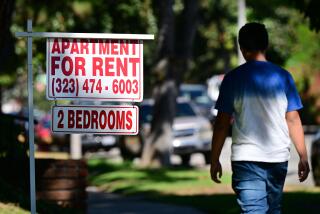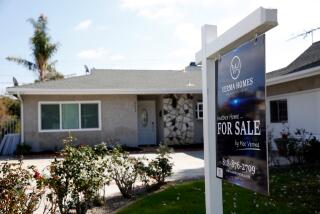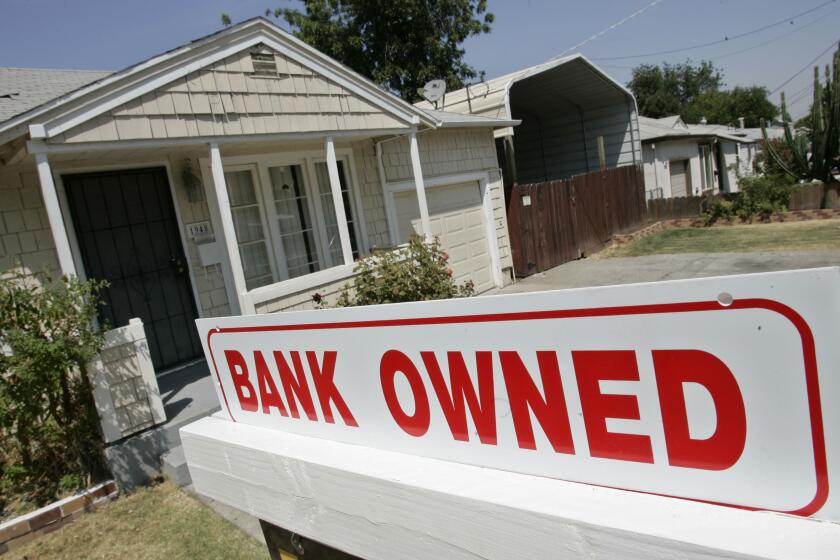Southern California’s housing market rebounds, but it may not last
The Southern California housing market is showing signs of heating up after a coronavirus-induced slump.
Sales are still below year-earlier levels but are up sharply from spring, when stay-at-home orders all but froze the market.
Some real estate agents say they are even seeing bidding wars.
“Every single place is getting multiple offers,” said Amber Dolle, an agent who specializes in the San Fernando Valley.
That level of activity may not last.
COVID-19 cases have surged throughout California as the economy reopened, causing the state to reimpose some restrictions. But for now, would-be buyers who still have the financial wherewithal seem eager to get their hands on mortgages with rock-bottom rates.
The latest evidence came this week when data firm DQNews released numbers for June.
Sales across the six-county Southern California region jumped 43.5% from May, the largest increase ever from May to June in a data set that dates from 1988.
Sales were still at a record low for a June and down 15.2% from a year earlier, but deals had declined 45% year over year in May and fell 31.5% in April.
The region’s median sale price, meanwhile, rose 2.9% from a year earlier to $555,500 in June, a record high. The median is the point at which half the homes sold for more and half for less.
Real estate agents said bidding wars are increasingly common because, as the economy reopened, buyers reentered a market with a low inventory and cheap mortgages.
Last week, the average rate on 30-year fixed-rate mortgages dipped below 3% for the first time on record and this week stood at 3.01%, down from 3.75% a year ago, according to Freddie Mac.
Many sellers pulled their homes off the market this spring after stay-at-home orders took effect and fears over the coronavirus surged. Listings have risen since April, but the number of homes for sale last month in Los Angeles and Orange counties was 26% below year-earlier levels, according to Zillow.
Mark Perez, a real estate agent in the Los Angeles area, said more sellers aren’t listing their homes because they underestimate the level of demand.
That may be understandable when the California unemployment rate sits at nearly 15% and no vaccine for the coronanvirus exists.
But Christopher Thornberg, founding partner with Beacon Economics, said most of the layoffs are believed to be temporary for now and focused in low-wage sectors such as retail where fewer people tend to have the means to buy a home in the first place.
The federal government has also pumped money into the economy through one-time cash payments, expanded unemployment benefits and small-business loans. And with fewer ways to spend money, Thornberg said, some households are saving more and wondering what to do with their extra cash.
“The fact the housing market isn’t doing even better is a lack of inventory,” Thornberg said.
Forbearance programs, which allow borrowers to delay mortgage payments, might also be playing a role in keeping prices high and inventory low. Experts say home sales usually decline before prices do in a market downturn because sellers are reluctant to drop their price until they have to.
Under the federal CARES Act, borrowers with a federally backed mortgage can delay payments for up to a year if they have a financial setback stemming from the coronavirus.
That means many struggling homeowners aren’t entering foreclosure or being forced to sell rapidly to stave off that credit-ruining prospect.
Forbearance, however, eventually ends, and borrowers may lose their homes if they can’t afford to make up the missed payments. The resurgent coronavirus also threatens to throw more people out of work, and expanded unemployment benefits under the CARES Act will expire soon.
Thornberg said the longer the pandemic continues, the more likely people will permanently lose their jobs and “that long-run damage will catch up to the housing market.”
But that will take time, he said, and he doesn’t expect the pandemic to last long enough to send home prices down meaningfully.
For her part, San Fernando Valley agent Dolle is bracing for a slowdown, believing the market is topping out.
Perez, the other agent, agreed.
“It can’t continue at this pace with record unemployment and small businesses going belly up,” he said. “It’s just not sustainable.”
Here’s how the June sales data broke down by county:
- In Los Angeles County, sales rose 40.8% from May and fell 24.3% from a year earlier. The median price rose 4% from a year earlier to $643,000.
- In Orange County, sales rose 49% from May and fell 22.1% from a year earlier. The median price rose 4.1% from a year earlier to $765,000.
- In Riverside County, sales rose 38.9% from May and fell 12% from a year earlier. The median price rose 7.8% from a year earlier to $430,000.
- In San Bernardino County, sales rose 36.6% from May and fell 3% from a year earlier. The median price rose 7.4% from a year earlier to $365,000.
- In San Diego County, sales rose 52.9% from May and fell 2.4% from a year earlier. The median price rose 1.7% from a year earlier to $600,250.
- In Ventura County, sales rose 49.7% from May and fell 23.9% from a year earlier. The median price rose 3.5% from a year earlier to $600,000.







